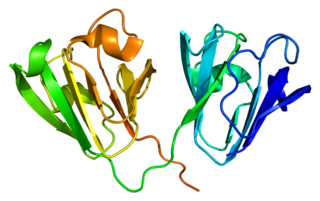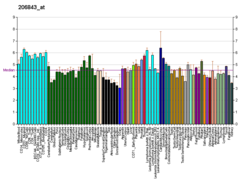
Gamma-crystallin D is a protein that in humans is encoded by the CRYGD gene.

Lens fiber major intrinsic protein also known as aquaporin-0 is a protein that in humans is encoded by the MIP gene.

Beta-crystallin B2 is a protein that in humans is encoded by the CRYBB2 gene.

Crystallin, gamma C, also known as CRYGC, is a protein which in humans is encoded by the CRYGC gene.

Beta-crystallin B1 is a protein that in humans is encoded by the CRYBB1 gene. Variants in CRYBB1 are associated with autosomal dominant congenital cataract.

Gamma-crystallin B is a protein that in humans is encoded by the CRYGB gene.

Beta-crystallin A3 is a protein that in humans is encoded by the CRYBA1 gene.

Gamma-crystallin S is a protein that in humans is encoded by the CRYGS gene.

Nucleoporin 50 (Nup50) is a protein that in humans is encoded by the NUP50 gene.

DNA topoisomerase 3-beta-1 is an enzyme that in humans is encoded by the TOP3B gene.

Thyrotroph embryonic factor is a protein that in humans is encoded by the TEF gene.

Beta-crystallin B3 is a protein that in humans is encoded by the CRYBB3 gene.

Gamma-crystallin A is a protein that in humans is encoded by the CRYGA gene.

Lens fiber membrane intrinsic protein is a protein that in humans is encoded by the LIM2 gene.

Protein DGCR6 is a protein that in humans is encoded by the DGCR6 gene.

Alpha-crystallin A chain is a protein that in humans is encoded by the CRYAA gene.

Beta-ureidopropionase is an enzyme that in humans is encoded by the UPB1 gene.

Guanine nucleotide-binding protein subunit beta-like protein 1 is a protein that in humans is encoded by the GNB1L gene.

Amyloid beta A4 precursor protein-binding family B member 1-interacting protein (APBB1IP), also known as APBB1-interacting protein 1 or Rap1-GTP-interacting adapter molecule (RIAM) is a protein that in humans is encoded by the APBB1IP gene.

Condensin-2 complex subunit H2, also known as chromosome-associated protein H2 (CAP-H2) or non-SMC condensin II complex subunit H2 (NCAPH2), is a protein that in humans is encoded by the NCAPH2 gene. CAP-H2 is a subunit of condensin II, a large protein complex involved in chromosome condensation.

















